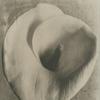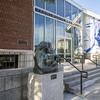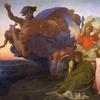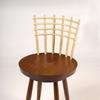Huntington Exhibition will Focus on Rare 19th-Century Astronomical Prints
- SAN MARINO, California
- /
- January 16, 2018
A rare set of exquisite lithographs, depicting the pastel drawings of planets, comets, eclipses and other celestial wonders by artist/astronomer Étienne Léopold Trouvelot (1827–1895), takes center stage in late April when The Huntington Library, Art Collections, and Botanical mounts the new exhibition “Radiant Beauty: E.L. Trouvelot’s Astronomical Drawings” in the Library’s West Hall. The exhibition is on view April 28–July 30.
The set of 15 chromolithographs was the crowning achievement of Trouvelot’s career, said curator Krystle Satrum, assistant curator of the Jay T. Last Collection at The Huntington. “He was both an extraordinarily talented artist and a scientist, producing more than 7,000 astronomical illustrations and some 50 scientific articles during his working life.”
In vivid color and meticulous detail, the works depict a range of astronomical phenomena. “The high quality of both the artwork and the scientific observation demonstrates his uncanny capacity to combine art and science in such a way as to make substantial contributions to both fields,” Satrum said.
Trouvelot’s artistic talent and eye landed him a position at the Harvard College Observatory, where he produced highly detailed drawings of his observations, many of which were published in the Annals of the Astronomical Observatory of Harvard College. In 1875, he was invited to the U.S. Naval Observatory to use their 26-inch refracting telescope, at the time, the world’s largest. He then went public, exhibiting several astronomical pastels at the 1876 Centennial Exposition in Philadelphia. With the success of that exhibit, Trouvelot sought to publish a portfolio of his best drawings. He teamed up with New York publishers Charles Scribner’s Sons, selecting 15 drawings to be made into chromolithographs, which were finally published in 1882.
It is estimated that some 300 portfolios were published, but only a handful of complete sets still exist. Initially the portfolios were sold to astronomy libraries and observatories as reference tools that astronomers could use to compare with their own observations. However, as early 20th century advances in photographic technology allowed for more accurate and detailed depictions of the stars, planets, and phenomena, these prints were discarded or sold to collectors. The Huntington’s set was acquired by Jay T. Last as part of his collection of graphic arts and social history, then donated to The Huntington.
Trouvelot’s legacy is not without controversy, said Satrum. Born in Aisne, France, he fled to the United States in 1855 with his wife and two children following Napoleon’s coup three years earlier, settling in Medford, Massachusetts. While supporting his family as an artist, he spent much of his free time studying insects, working to see if better silk-producing caterpillars could thrive in the United States. During a trip back to France in the late 1860s, he collected live specimens of the gypsy moth, bringing them home to Medford. “Unfortunately, after hatching, some of them escaped his backyard, infesting the nearby woods, then quickly spread throughout New England and Canada, destroying millions of hardwood trees,” she said. Though large-scale efforts to eradicate it were underway by 1890, they proved unsuccessful; the gypsy moth continues to be a scourge of U.S. and Canadian forests today, causing millions of dollars’ worth of damage annually. “This episode also seems to have soured Trouvelot’s passion for entomology, for by 1870, he had turned to astronomy,” Satrum said.
The West Hall is adjacent to the astronomy section of “Beautiful Science: Ideas that Changed the World” The Huntington’s permanent exhibition on the history of science, featuring rare books and manuscripts by the likes of Ptolemy, Galileo, Newton, and Einstein, among others.


270x400_c.jpg)












100x100_c.jpg)